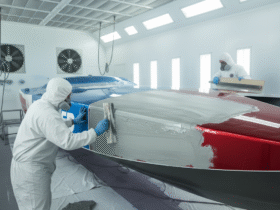In the construction and heavy lifting industry, efficiency and cost management are critical factors in project success. Among the various equipment options available, truck mounted cranes have emerged as a versatile and cost-effective solution for many lifting and material handling tasks. These cranes combine mobility with powerful lifting capabilities, making them ideal for a wide range of applications—from construction sites to utility maintenance and logistics operations.
But how do truck-mounted cranes compare to traditional crane options in terms of cost-effectiveness? Are they truly a smart investment for businesses looking to optimize their operations? This article explores the financial and operational advantages of truck-mounted crane services, comparing them with alternative lifting solutions and examining key factors that influence their cost efficiency.

What Is Truck Mounted Cranes?
Truck-mounted cranes are hydraulic cranes installed on a commercial truck chassis, offering both mobility and lifting power in a single unit. Unlike stationary or crawler cranes, which require separate transportation, these cranes can travel on public roads and quickly move between job sites. They come in various sizes, with lifting capacities ranging from a few tons to over 100 tons, making them suitable for diverse tasks such as:
- Construction material handling(steel beams, concrete panels, prefabricated structures)
- Utility and power line maintenance
- Equipment installation(HVAC units, generators, industrial machinery)
- Disaster recovery and emergency lifting operations
Because they eliminate the need for additional transport equipment, truck-mounted cranes can significantly reduce project costs and time.
Beyond the fundamental cost comparisons, there are several nuanced factors that can further enhance the financial advantages of truck-mounted crane services. These additional considerations help businesses extract even greater value from their equipment investments.
Optimizing Fleet Utilization Strategies
One often-overlooked aspect of cost-effectiveness is fleet optimization. Companies can implement several strategies to maximize the productivity of their truck-mounted cranes:
Geographic Route Planning – By clustering jobs in similar locations, operators can minimize deadhead miles between sites. Advanced GPS tracking systems now allow for real-time route optimization that accounts for traffic patterns and job site accessibility.
Multi-Shift Operations – Some forward-thinking companies have implemented twilight or overnight shifts for their cranes, particularly in urban environments where daytime traffic restrictions apply. This approach can effectively double the equipment’s productive hours.
Cross-Training Personnel – Training operators to perform basic maintenance and rigging tasks creates a more flexible workforce that can adapt to changing job requirements without additional labor costs.
Emerging Technologies Enhancing Efficiency
The integration of new technologies is creating additional cost-saving opportunities:
Telematics Systems – Modern crane monitoring systems provide detailed data on fuel consumption, idle times, and maintenance needs. This information allows for precise cost allocation to specific projects and identification of potential savings.
Automated Load Monitoring – Advanced sensors can now calculate optimal load distributions automatically, reducing setup times and minimizing the risk of costly errors or accidents.
Predictive Maintenance Tools – AI-driven diagnostics can forecast component failures before they occur, preventing expensive downtime and extending equipment lifespan.
Alternative Business Models Worth Considering
Beyond traditional ownership or rental models, several innovative approaches are emerging:
Crane Sharing Cooperatives – Some contractors in regional markets have formed equipment-sharing networks, allowing members to access truck-mounted cranes at reduced rates during their off-peak periods.
Pay-Per-Lift Programs – Certain rental companies now offer usage-based pricing models where customers pay only for the actual lifting time rather than full-day rates.
Residual Value Leasing – Smart lease agreements that account for the strong secondary market for quality used truck-mounted cranes can significantly reduce total ownership costs.
Hidden Insurance and Liability Advantages
Truck-mounted cranes offer some often-underestimated financial protections:
Reduced Insurance Premiums – Their road-legal status typically results in lower insurance costs compared to specialized lifting equipment that requires separate transport.
Simplified Compliance – Meeting DOT regulations for a single integrated unit is generally less costly than maintaining compliance for separate tractor and trailer combinations.
Lower Liability Exposure – The standardized nature of truck-mounted operations reduces training requirements and associated liability risks compared to more complex lifting systems.
Sustainability-Related Cost Benefits
Environmental considerations are increasingly translating to direct financial advantages:
Fuel Efficiency Gains – Newer truck-mounted crane models feature hybrid power systems that can cut fuel costs by 20-30% in typical urban operating conditions.
Emission Regulation Compliance – Their ability to meet current and anticipated future emissions standards protects against costly retrofitting or replacement mandates.
Green Project Incentives – Some municipal projects now offer bidding advantages or financial incentives for contractors using equipment with lower carbon footprints.
Conclusion: A Holistic Approach to Cost Management
While the fundamental cost advantages of truck-mounted cranes are clear, truly maximizing their value requires looking beyond simple rate comparisons. By implementing strategic utilization plans, embracing new technologies, exploring innovative business models, and accounting for all potential savings streams, businesses can unlock additional layers of cost-effectiveness.
The most successful operators treat their truck-mounted cranes not just as pieces of equipment, but as integrated productivity systems where every component – from maintenance scheduling to operator training – contributes to the bottom line. This comprehensive approach to cost management ensures that truck-mounted crane services deliver not just immediate savings, but sustain financial advantages throughout their service life.










Leave a Review